COLONIALISM
"Colonialism
is the process that results in the control of one people's territory by
another."
Jim Reynolds, Canada and Colonialism An Unfinished Business
"The
process [of colonialism] was rooted in a shared economic goal, belief in racial
and cultural superiority, and a readiness to use force if other preferred
measures, such as treaty making, did not succeed. . . Within settler colonies,
the sense of entitlement led to the settler demanding access to the resources
of those colonies with limited regard for the claims of the Indigenous
people."
Jim Reynolds, Canada and Colonialism An Unfinished Business

"This
Doctrine of Discovery was linked to a second idea: the lands being claimed were
terra nullius–no mans land–and therefore open to
claim. . . the indigenous people simply occupied, rather than owned land. True ownership they claimed could come only with European
–style agriculture."
Final
Report of the Truth and Reconciliation Commission of Canada, Volume 1
"The
Doctrine of Discovery was issued by Pope Alexander VI in
1493. . . The Doctrine dictated that lands not occupied by Christians
could be claimed in the name of the explorers. . . Indigenous people were
consistently refereed to as 'savages' by all the
European empires–an undeniably racist term coined by thieving minds to justify,
in both religious and legal terms, the theft of Indian lands. . . The Doctrine
upheld the notion that, because Indigenous people were non-Christians, they
were inferior, uncivilized and not human–and therefore their land was empty or
'terra nullius."
Chief Clarence Louie, Rez Rules
Doctrine
of Discovery and Terra Nullius
https://www.ictinc.ca/blog/christopher-columbus-and-the-doctrine-of-discovery-5-things-to-know
[The
Royal Proclamation of 1763 stated that Aboriginal title existed and that all
land would be considered Aboriginal until ceded by treaty.]
"The Royal Proclamation of 1763 . . . places a duty upon the Crown
to engage in treaty making with Indigenous Peoples and wherein King George III
expressly forbade the taking of Indigenous lands without agreement and
consent."
Michelle Good, Truth Telling
"The Royal Proclamation Act of 1763 prohibited settlers from
claiming land from Indigenous people unless and until it was first surrendered
to the Crown."
Jim Reynolds, Canada and Colonialism An Unfinished Business

"Rather than sending soldiers and guns to control the
owners of the land the government had the missionaries who influenced the
Native people to limit their movements, take up an agricultural lifestyle, and
abandon their culture."
Celia Haig-Brown
"In the Colony of Upper Canada, the Darling Report of 1828
promoted what became known as the civilization and assimilation program. It
recommended this program be based on establishing reserves where Indigenous
peoples could be educated, converted to Christianity, and transformed into
sedentary farmer, thus ending their nomadic habits."
Jim Reynolds, Canada and Colonialism An Unfinished
Business



"First
Nations people soon [after Confederation] became minorities on their
traditional lands and were viewed as a disappearing race, an encumbrance and an
obstacle to settlement and progress who would soon cease to exist."
Jim Reynolds, Canada and Colonialism An Unfinished
Business

[The
term 'Civilization' or 'Progress' was used to justify the conquest and
dispossession of peoples native to their lands. The Civ/Sav doctrine permeates
Canadian culture.]
"Aboriginal
peoples . . . are still being hounded and haunted by White North America's
image machine, which has persistently portrayed them in extremes as either the
grotesque ignoble or noble savage. . . The Civ/Sav doctrine
(Civilization/Savage) permeates Canadian culture and is obviously very powerful
. . . it dichotomizes Native-White relations in terms of civilization
inevitably winning over savagery. . . Aboriginal Nations fighting to save their
persons, communities, cultures, and lands was propagandized as simple
irrational violence of bloodthirsty savages."
Emma LaRocque, When the Other is Me Native Resistance Discourse 1850-1990



"The
creation of Canada . . . was above all an act of imperialism. A nation-state
annexed land inhabited by many other nations and then made them second-class
citizens."
Will Ferguson, Why I Hate Canadians
"Shall
we allow a few vagrants (First Nations) to prevent forever industrious settlers
from settling on unoccupied land."
Amor de Cosmos
"Clearing
the land now called Canada and the United States of Indians to allow for white
settlement and resource development has always been at the heart of federal,
provincial and state government Indigenous policy."
Chief Clarence Louie, Rez Rules






"Settler
colonialism involves displacing Indigenous peoples from their land and
replacing them with expatriate settlers. Its underlying impulse is to eliminate
Indigenous peoples from ownership of valuable
resources, particularly land and to elevate settler families as legitimate and
therefore entitled to land. Settler women's reproductive labour
was central to the process of repopulating what were once Indigenous lands in
Canada. Residential schools and other strategies, including restricting the
franchise to settlers, also eliminated the power and cultures of Indigenous
peoples. . . Settler women were complicit in the dispossession of Indigenous
land."
Sara Carter, Ours By Every Law of Right and
Justice Women and the Vote in the Prairie Provinces


"Colonialism
is the invasion and occupation of other lands for the purpose of settlement
and/or acquiring resources."
Gord Hill, The 500 Years of Indigenous Resistance Comic Book
"Land
is literally at the heart of the colonial objective. . . Colonial Indian policy
was similar throughout the Americas: (1) acquire Indigenous lands and
resources. . . and (2) get rid of the Indian
problem through either elimination or assimilation."
Pamela Palmater, The 500 Years of Indigenous
Resistance Comic Book



[Superintendent
General of Indian Affairs Hon. Frank Oliver portrayed as a bandit for the way
he handled a reserve surrender. "[Oliver] was a blatant racist . . . He
regarded First Nations as an inferior race, who had no place in the new society
taking place on the western plain."
Bill
Waiser and Jennie Hansen, Cheated The Laurier Liberals and the Theft of
First Nations Reserve Land.]
"Canada's
First Nations had a treaty right to reserves, a solemn promise by Indian
Commissioner Alexander Morris that they were 'inviolate so long as the grass
grows and the sun shines.' But the Laurier government broke this treaty promise
by embarking on a concerted campaign to take away reserve land. Twenty-one
percent of prairie reserves (one in five acres)
was surrendered between 1896 and 1911. . . So
much for the honor of Canada."
Bill Waiser and Jennie Hansen, Cheated The Laurier Liberals and the Theft of First Nations Reserve
Land.
"The interests of the people must
come first [when discussing the surrender of Indian reserve lands] and if it
becomes a question between the Indians and the whites, the interests of the
whites will have to be provided for."
Frank Oliver, House of Commons Debates, 30 March 1906

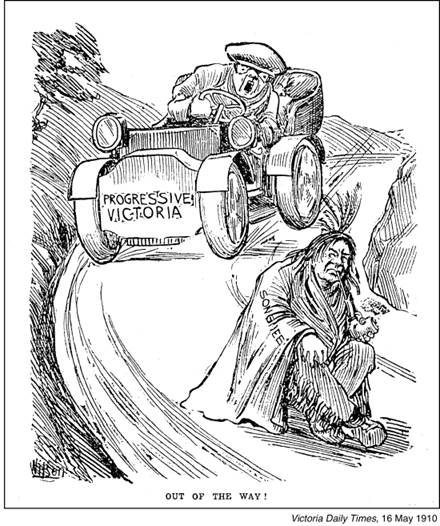
[In
1911 Prime Minister Laurier passed legislation making it possible to legally
remove the residents from an Indian reserve without their consent when they
lived wholly or partly within an incorporated town. Despite their objections,
each member of the Songhees reserve was given new land at nearby Esquimalt and
paid $10,000.]

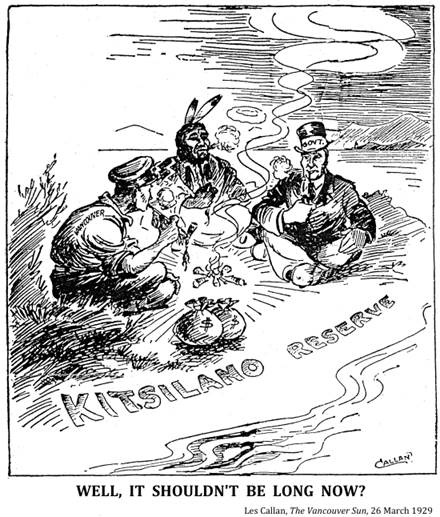
[In
1930 eight acres of a disputed Kitsilano Reserve were alienated for the present
Burrard Street Bridge and in 1934 four acres were alienated for the Seaforth Armouries.]
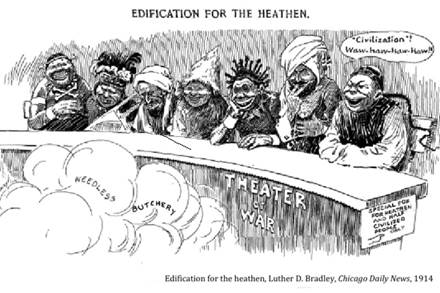

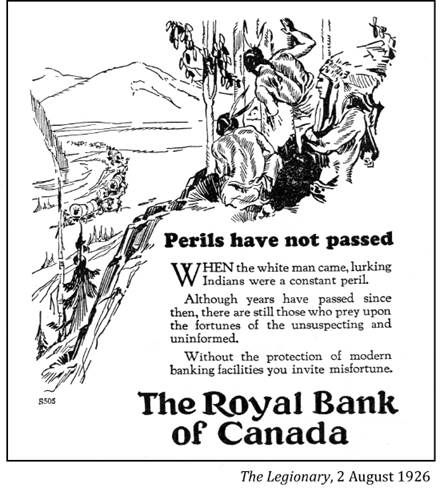
"A
white man, long ago, spoke to an Indian sitting on the large end of a log.
'Please, sit over!' he said. The Indian saw no harm in it; he move a bit and allowed the stranger to sit on the log beside
him. The newcomer repeated, 'Sit over!' So he did. But
it was not enough. 'Sit over, sit over!' The Indian before long found himself
at the small end of the log. The white man declared, 'The log now is my
own!'"
Marius Barbeau, "Our Indians – Their Disappearance", Queen's
Quarterly, 1931
"Life
has indeed been made 'easier' for them [Indians] since the introduction of the
rifle, the steel axe and the iron pot, not to speak of clothing, castile soap
and a decent language! Formerly they idled away their existence in squalor and
crass ignorance. Their idiom was a mere growl
from the throat Their tools were of stone and antler, and their artifacts fit
only for a bonfire. Their companions were the animals of the forest or the
prairies. Their dwellings were huts and movable tents, where they froze in
winter and starved between seasons. In a word, they were uncivilized; they were
savage men of the wilds with unaccountable ways of their own; they were
heathens, the true wards of Satan, with no knowledge of God and his favourite son, the white man."
Marius Barbeau, Our Indians, Queen's Quarterly, 1931


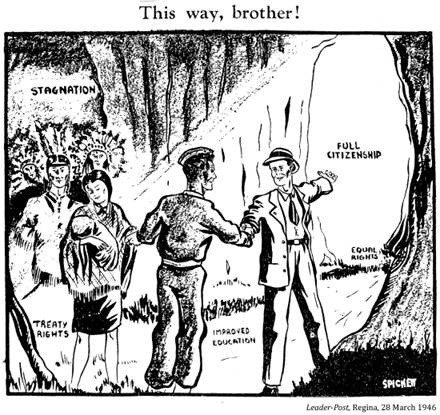


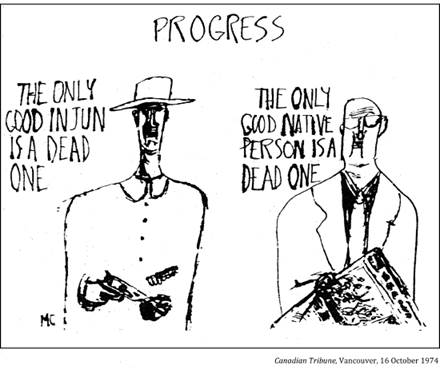

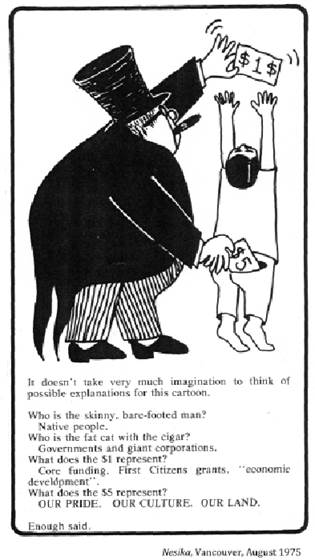



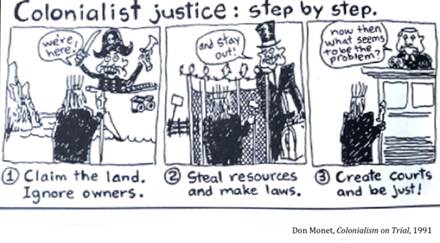


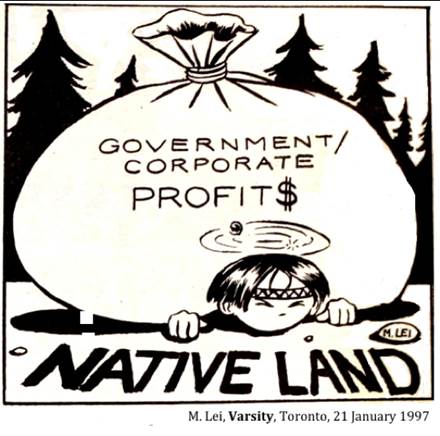
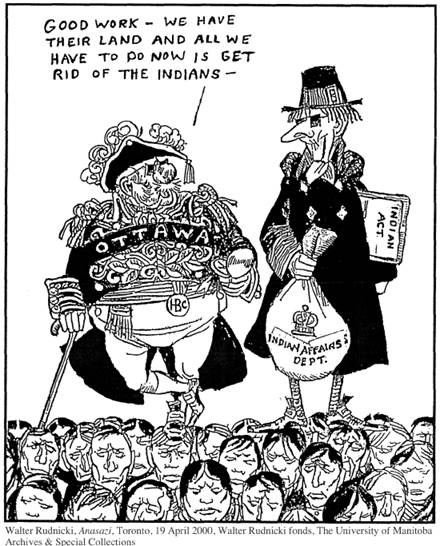
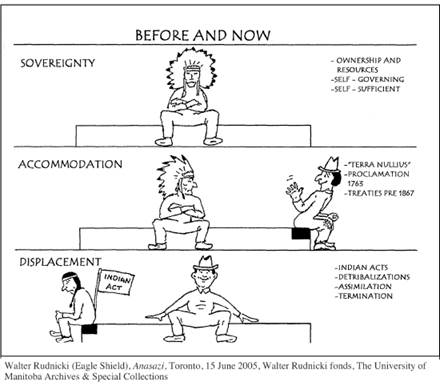
"The
Canadian government pursued this policy of cultural genocide [assimilation]
because it wished to divest itself of its legal and financial obligations to
Aboriginal people and gain control over their land and resources."
Truth
and Reconciliation Report,
2007.
"We
have no history of colonialism."
Stephen Harper
An
Indigenous Perspective:
In Cree
artist Kent Monkman’s The Subjugation of Truth Chief
Poundmaker and Chief Big Bear are placed in the foreground losing their lands
as settler leaders including John A. Macdonald take away their future. The
primary figures are Indigenous leaders whose land is being stolen, not the
former prime minister who engineered its theft. [2016]
https://www.kentmonkman.com/painting/2017/1/9/the-subjugation-of-truth-1